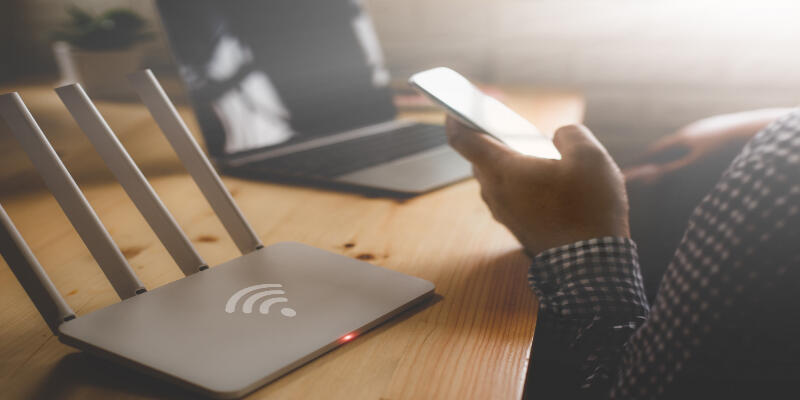Disclaimer: This post may contain affiliate links, meaning we get a small commission if you make a purchase through our links, at no cost to you. For more information, please visit our Disclaimer Page.
To those who are unfamiliar with how your internet connection works, some assume that the internet is provided by the wireless router. WiFi connection is provided to its users through the means of the router, while the internet connection itself is transmitted from the modem to the router. You might be or have used a WiFi modem before if you only received one device from your internet provider.
You need an internet provider if your wireless router is for setting up a WiFi network. You may also need an internet provider if you are setting up a local area network with internet for a group of computers.
As a network specialist, I can also use the wireless router without having an internet provider. However, that is for other purposes that do not need internet. I will also teach you those, along with some questions that you surely want to raise on this topic.
Table of Contents
Do You Need An Internet Provider To Use A Wireless Router?
An internet provider is mostly required when operating a wireless router. But are times where you don’t completely need them at all. I will share everything I know when using the wireless router for both online and offline tasks and tricks.
The modem and router indeed have the following similarities:
- Flashing lights
- Ports and jacks, particularly at the back part.
- They look similar, but not identical.
- Both are provided by an internet service provider.
- They usually require an ethernet cable.
The following are what confuses a lot of people, especially the non-tech-savvy ones. But you have to remember the following differences, which I will explain in the next question explained in detail.
Does A Wireless Router Provide Internet?
The wireless router does not provide any internet connection if you are going to use it as a standalone device. If you’re wondering why your WiFi network is showing up on your phone, it’s because your router is turned on. The WiFi connection that you see is transmitted by a router, but will not provide any internet data if there is no modem connected to it.
A modem is the main device sold by internet providers. Some providers sell or give away routers as well due to the demand for WiFi. The main switch of the internet provider transmits the data to their modem, and then to the router before it is provided via WiFi for everyone to enjoy.
But how does a modem provide the connection to the router? All you need to do is to connect the modem using an ethernet cable to the router’s Internet port at its back.
The other slots are for providing local area network connection between PCs and laptops, which I will also share in the next question.
Note: You can still use your wireless router’s WiFi while using a wired connection to your or a group of computers. Just make sure your current internet speed is sufficient for every device connected, wired or wireless.
Will A Wireless Router Work Without Internet?
The wireless router is still useful without an internet connection. However, this may not apply to some people, since most only buy a router to access WiFi. Here are the different things you can do with a wireless router if there is no internet:
Change the Router Settings
You can do a lot of stuff on your router, particularly if you are already familiar with the technical terms provided by the router settings. But for beginners, here is a tip that for sure you are all familiar with:
- Change the password by accessing the router’s IP address on your browser found at the label of the device. (it looks like 192.168.0.0)
- The admin username and password, which is also found at the router’s label or manual, is needed to be entered. Most of the time, admin is the default username and password.
- Go to the router’s Change WiFi Password option found at the menu to the left side of the router dashboard. The term might be different depending on your router’s make and model.
- Look for the detail there that says Password or Network Key.
- Change it and then do the same for the WiFi name or SSID.
- Congratulations, you now customized your WiFi name and password!
This is the easiest setting to change in your router’s dashboard. You can also do the following if you want to change the admin username and password:
- Enter IP address in your browser
- Enter the current admin username and password.
- Go to the router’s Change Router Password option found at the menu to the left of the dashboard, or any similar term.
- Look for the detail that says Username and Password. Enter the desired admin username and password on that field. You might need to enter the password twice, depending on the router’s version.
- You will be logged off your router’s dashboard and will be prompted to enter the new credentials.
If you want something advanced, like controlling the bandwidth to get the most speeds in your router network once you have internet, here are the steps:
- Do the first two steps mentioned above when entering your router’s dashboard.
- Look for Bandwidth Control Settings at the dashboard of your router. The option might be found in the main menu. It could be found at a different option inside one of the main options found on the dashboard.
- You will see two options there called ingress Bandwidth and Egress Bandwidth, with its values entered automatically by your internet provider.
- Go to Rules List to see a table of registered IP addresses in your device, along with the minimum and maximum ingress and egress bandwidths.
- Choose Add New Rule, Add New or New Rule found below the table.
- Enter the desired IP address range (these are the IP addresses being provided by your router to the devices. They are uniquely indicated by the last digit of the address. You can choose between 00 to the maximum amount.
- Change the Min and Max Egress Bandwidth and Ingress Bandwidth.
- Press Save to register the rule to the table. This will then control the amount of bandwidth of all devices occupying the IP addresses that you entered.
There are a lot of options that you can navigate in your router. If you think you messed up your router, just perform a hard reset by pressing and holding the reset button at the back of the device. You can also do it in your router’s dashboard, usually found at the very bottom option.
But if you’re still insisting if there is any way to get WiFi in your house without the need of an internet provider, there is a possibility! I will share with you a very nice trick once you read the last question.
If You Buy A Wireless Router, Do You Have To Pay For Internet?
You need to pay for internet service if you need to buy your wireless router as a WiFi device at home or in your office. You can only access the router dashboard in your browser if it does not have an internet modem connected to it.
All you have to do is contact your local internet provider to connect your router to the internet. If you cannot acquire a postpaid service, you can ask for prepaid internet service. Both offer connection through the use of a modem that works well with a wireless router.
But you do not need to buy another internet service if you have another router. The second router can become an extension of your internet connection by connecting it to the router connected to the internet service. The next question will cover how to turn your second router into an Access Point.
How Can I Get WiFi In My House Without Internet?
To those who insist to acquire an internet connection with a standalone router, you can simply extend someone’s WiFi connection. This can be achieved by turning your router into an access point for a WiFi connection. Back then, you can extend your wired connection by connecting a router to another one through its LAN port.
Now, you just need to change some options in your router’s dashboard to make this possible without the need to buy and untangle some ethernet cables. This is often done by malls to make their large public WiFi setup easy to establish. Here are the steps:
- Note: This can only be achieved if there is a nearby WiFi network. You can ask a friend to see if you can manage to acquire some details (which I will discuss in the next steps) to make this possible. The router we’re trying to connect to will be called a WiFi router.
- Find the WiFi router’s IP address by going to your computer’s CMD or Mac’s Network Option.
- Windows
- Type cmd in your search bar to access the Command Prompt.
- Type ipconfig then press Enter. Look for the Default Gateway of the router. That is the IP address of the WiFi router.
- Mac
- Go to System Preferences > Network > then choose the current connection
- Go to Advanced > check the TCP/IP tab, and choose Router. The IP address is written there.
- Windows
- Next, look for the IP range of the WiFi router. The range usually starts from 192.168.0.1 to 253. For this tutorial, the IP address of the WiFi router ends with 1.
- Repeat the steps above to acquire the IP range of your router.
- Go to your router’s dashboard and choose Network or any term related to it such as LAN.
- Change the IP address of your router to a value next to the WiFi router’s current IP address.
- Press Save for your router to restart and apply the changes.
Note that the following steps may vary depending on the two router’s make and model. I have tested the following steps by asking a friend to use their computer and router information. So if you want to connect to someone else, be sure to ask politely first.
Conclusion
As the name suggests, a router is what routes your internet connection I love using routers because these nifty devices are what started my drive to learn networking as a career. If you want to become an expert in your WiFi network, just keep these tips and tricks in mind to get started!


